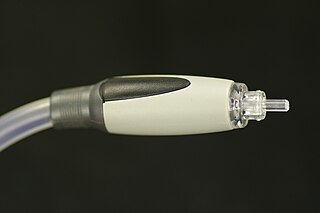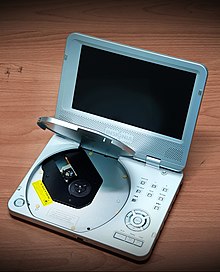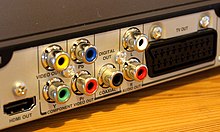
Video is an electronic medium for the recording, copying, playback, broadcasting, and display of moving visual media. Video was first developed for mechanical television systems, which were quickly replaced by cathode-ray tube (CRT) systems, which, in turn, were replaced by flat-panel displays of several types.

Video CD is a home video format and the first format for distributing films on standard 120 mm (4.7 in) optical discs. The format was widely adopted in Southeast Asia, South Asia, Greater China, Central Asia and West Asia, superseding the VHS and Betamax systems in the regions until DVD-Video finally became affordable in the first decade of the 21st century.

Digital Visual Interface (DVI) is a video display interface developed by the Digital Display Working Group (DDWG). The digital interface is used to connect a video source, such as a video display controller, to a display device, such as a computer monitor. It was developed with the intention of creating an industry standard for the transfer of uncompressed digital video content.

SCART is a French-originated standard and associated 21-pin connector for connecting audio-visual (AV) equipment. The name SCART comes from Syndicat des Constructeurs d'Appareils Radiorécepteurs et Téléviseurs, "Radio and Television Receiver Manufacturers' Association", the French organisation that created the connector in the mid-1970s. The related European standard EN 50049 has then been refined and published in 1978 by CENELEC, calling it péritelevision, but it is commonly called by the abbreviation péritel in French.

S-Video is an analog video signal format that carries standard-definition video, typically at 525 lines or 625 lines. It encodes video luma and chrominance on two separate channels, achieving higher image quality than composite video which encodes all video information on one channel. It also eliminates several types of visual defects such as dot crawl which commonly occur with composite video. Although it improved over composite video, S-Video has lower color resolution than component video, which is encoded over three channels.

Component video is an analog video signal that has been split into two or more component channels. In popular use, it refers to a type of component analog video (CAV) information that is transmitted or stored as three separate signals. Component video can be contrasted with composite video in which all the video information is combined into a single signal that is used in analog television. Like composite, component cables do not carry audio and are often paired with audio cables.
Enhanced-definition television, or extended-definition television (EDTV) is a Consumer Electronics Association (CEA) marketing shorthand term for certain digital television (DTV) formats and devices. Specifically, this term defines an extension of the standard-definition television (SDTV) format that enables a clearer picture during high-motion scenes compared to previous iterations of SDTV, but not producing images as detailed as high-definition television (HDTV).

High-Definition Multimedia Interface (HDMI) is a proprietary audio/video interface for transmitting uncompressed video data and compressed or uncompressed digital audio data from an HDMI-compliant source device, such as a display controller, to a compatible computer monitor, video projector, digital television, or digital audio device. HDMI is a digital replacement for analog video standards.

YPbPr or Y'PbPr, also written as YPBPR, is a color space used in video electronics, in particular in reference to component video cables. Like YCbCr, it is based on gamma corrected RGB primaries; the two are numerically equivalent but YPBPR is designed for use in analog systems while YCBCR is intended for digital video. The EOTF may be different from common sRGB EOTF and BT.1886 EOTF. Sync is carried on the Y channel and is a bi-level sync signal, but in HD formats a tri-level sync is used and is typically carried on all channels.
A DVD recorder is an optical disc recorder that uses optical disc recording technologies to digitally record analog or digital signals onto blank writable DVD media. Such devices are available as either installable drives for computers or as standalone components for use in television studios or home theater systems.

DTS, Inc. is an American company. DTS company makes multichannel audio technologies for film and video. Based in Calabasas, California, the company introduced its DTS technology in 1993 as a competitor to Dolby Laboratories, incorporating DTS in the film Jurassic Park (1993). The DTS product is used in surround sound formats for both commercial/theatrical and consumer-grade applications. It was known as The Digital Experience until 1995. DTS licenses its technologies to consumer electronics manufacturers.
Dolby Digital Plus, also known as Enhanced AC-3, is a digital audio compression scheme developed by Dolby Labs for the transport and storage of multi-channel digital audio. It is a successor to Dolby Digital (AC-3), and has a number of improvements over that codec, including support for a wider range of data rates, an increased channel count, and multi-program support, as well as additional tools (algorithms) for representing compressed data and counteracting artifacts. Whereas Dolby Digital (AC-3) supports up to five full-bandwidth audio channels at a maximum bitrate of 640 kbit/s, E-AC-3 supports up to 15 full-bandwidth audio channels at a maximum bitrate of 6.144 Mbit/s.
Dolby TrueHD is a lossless, multi-channel audio codec developed by Dolby Laboratories for home video, used principally in Blu-ray Disc and compatible hardware. Dolby TrueHD, along with Dolby Digital Plus (E-AC-3) and Dolby AC-4, is one of the intended successors to the Dolby Digital (AC-3) lossy surround format. Dolby TrueHD competes with DTS's DTS-HD Master Audio, another lossless surround sound codec.

The Sony BDP-S1 is a first generation Blu-ray Disc (BD) player and is the first such player released in North America. It was originally scheduled for release in the United States on August 18, 2006 with a MSRP of $999.95. Sony had postponed the release date of this player several times and it was released on December 4, 2006.

An audio/video receiver (AVR) is a consumer electronics component used in a home theater. Its purpose is to receive audio and video signals from a number of sources, and to process them and provide power amplifiers to drive loudspeakers and route the video to displays such as a television, monitor or video projector. Inputs may come from a satellite receiver, radio, DVD players, Blu-ray Disc players, VCRs or video game consoles, among others. The AVR source selection and settings such as volume, are typically set by a remote controller.
The first attempt at producing pre-recorded HDTV media was a scarce Japanese analog MUSE-encoded laser disc which is no longer produced.
GameCube accessories include first-party releases from Nintendo, and third-party devices, since the GameCube's launch in 2001.
Audio connectors and video connectors are electrical or optical connectors for carrying audio or video signals. Audio interfaces or video interfaces define physical parameters and interpretation of signals. For digital audio and digital video, this can be thought of as defining the physical layer, data link layer, and most or all of the application layer. For analog audio and analog video these functions are all represented in a single signal specification like NTSC or the direct speaker-driving signal of analog audio.

TOSLINK is a standardized optical fiber connector system. Also known generically as optical audio, its most common use is in consumer audio equipment, where it carries a digital audio stream from components such as CD and DVD players, Digital Audio Tape recorders, computers, and modern video game consoles, to an AV receiver that can decode two channels of uncompressed pulse-code modulated (PCM) audio or compressed 5.1/7.1 surround sound such as Dolby Digital or DTS Surround System. Unlike HDMI, TOSLINK does not have the bandwidth to carry the uncompressed versions of Dolby TrueHD, DTS-HD Master Audio, or more than two channels of PCM audio.
Various accessories for the PlayStation 2 video game console have been produced by Sony, as well as third parties. These include controllers, audio and video input devices such as microphones and video cameras, and cables for better sound and picture quality.















